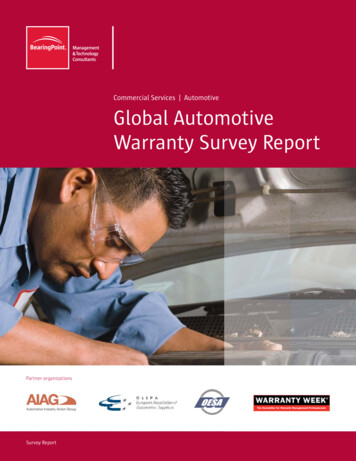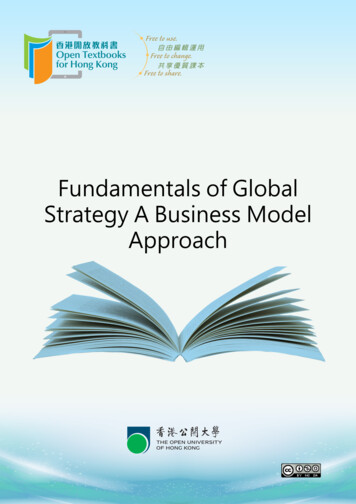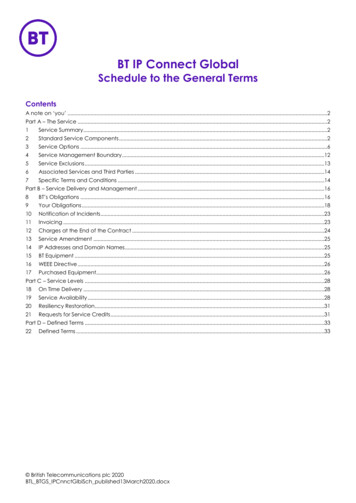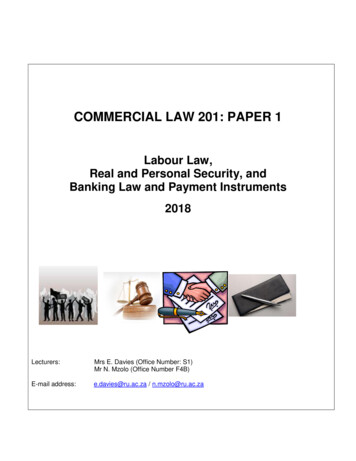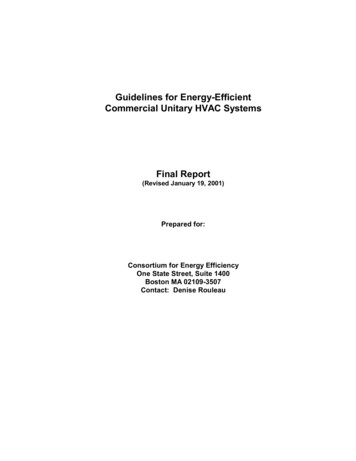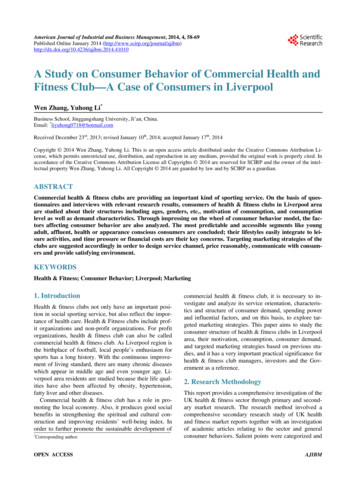![Global Commercial Strategy [L6M2] - CIPS](/img/2/l6m2-sample-answer-20guide-fv-20v3.jpg)
Transcription
CIPS Level 6 – Professional Diploma in Procurement andSupplyGlobal Commercial Strategy[L6M2]Sample answer guideApril 2020 V2Leading global excellence in procurement and supply
(Q1)Question oneAssess the characteristics of strategic decisions which should be considered when developing a globalstrategy in organisations.[25 marks]LO: 1AC: 1.1Planning your answerCommand WordsIt is important in any constructive response question to understand the Command word used in the questionas they tell you exactly what the assessor wants you to do. In this question the assessor will want you toclearly Assess the characteristics of strategic decisions which should be considered when developing a globalstrategy in organisations.The Command word in this question is Assess: “Evaluate or judge the importance of something, referring tothe special knowledge of experts where possible. This may involve quoting from other texts.”Answering the questionA good approach to answering this question would be to have a short introduction that recognises strategicdecisions are the means by which an organisation’s vision is translated into actions and that these types ofdecisions have key characteristics.Johnson and Scholes suggested that characteristics most pertinent to strategic decisions include: Long term in direction; Scope of an organisation’s activities; Competitive advantage development; Strategic fit with global business environment; Organisation resources and competences and Values and expectations of stakeholdersWe can then go on to assess perhaps around five of these in breadth and depth to accrue good marks.This approach helps to ensure that you understand the question, recognise the command word and assessthe characteristics of strategic decisions which should be considered when developing a global strategy inorganisations.2
The following is suggested answer content rather than a model answer.Characteristics of strategic decisions which should be considered when developing a global strategy inorganisations include but not limited to: The long-term direction of an organisation.This can include for example Product Development. Product Life Cycles particularly in areas of hightechnology are reducing rapidly. Competing companies such as Apple and Samsung are introducing newtechnologies with each new product launch. Savvy technology companies are developing products using 5Gtechnologies to replace current products and develop new ones for new markets. Scope of the OrganisationStrategic decisions are likely to be concerned with the scope of an organisation’s activities. For example,does (and should) the organisation concentrate on one area of activity, or should it have many? The issue ofscope of activity is fundamental to strategy because it concerns the way in which those responsible formanaging the organisation conceive the organisation’s boundaries. This could include important decisionsabout product range or geographical coverage including global aspects. Amazon for example has progressedfrom book selling to become a global e-commerce giant operating a multitude of different businesses. Competitive Advantage DevelopmentStrategic decisions are normally about trying to gain competitive advantage for the organisation over itscompetition. Refer to 5G technologies above as an example. Companies who stay with 3G/4G may and arelikely to be, overtaken in the market. Historically companies such as Polaroid, Xerox, and Hoover may beexamples of companies who lost sight of technological change. Ericsson, Nokia and Motorola were cellphone global market leaders and have disappeared completely from this market having been overtakenentirely by smartphone technology leaders such as Apple and Samsung. Strategic Fit with Global Business EnvironmentStrategy can be seen as the search for strategic fit with the business environment. This could require majorresource changes for an organisation in the future. For example, decisions to expand geographically orglobally may have significant implications in terms of the need to build and support a new customer base. Itis important to achieve the correct positioning of the organisation, for example in terms of the extent towhich products or services meet clearly identified market needs. Tesco’s for example failed with theirgeographical expansion into the U.S. Resources & CompetencesStrategy can also be seen as creating opportunities by building on an organisation’s resources andcompetencies. This is called the resource-based view of strategy, which is concerned with exploiting thestrategic capability of an organisation, in terms of the resources and competences, to provide competitiveadvantage and/or yield new opportunities. For example, a large multinational corporation may focus itsstrategies on those businesses with strong brands. Amazon progressed and expanded from book sellingover the internet by leveraging their technology platforms. Values and Expectations of StakeholdersThe strategy of an organisation is affected not only by environmental forces and strategic capability, but alsoby the values and expectations of those who have power in and around the organisation. Sustainable3
product development and ethical sourcing is now very much to the fore in the global strategy of manyorganisations.There are numerous other characteristics of strategic decisions to which answers may refer for exampleuncertainty, subjectivity and risk.There are also many other important writers in the area of business strategy and strategic decisions that canbe referenced to include but not limited to Pearce & Robinson 2005 and Ezendu 2011.Other valid responses and answers will be accepted.(Q2)Question 2Using the Five Forces Framework, evaluate the competitive environment of an organisation with which youare familiar.[25 marks]LO: 2AC: 2.1Planning your answerCommand WordsIt is important in any constructive response question to understand the Command word used in the questionas they tell you exactly what the assessor wants you to do. In this question the assessor will want you toclearly 'Evaluate the competitive environment of an organisation with which you are familiar, using the FiveForces Framework.’The main Command word in this question is Evaluate “Calculate or judge the value of something; includeyour personal opinion in your evaluation. Often includes an assessment of strengths and weaknesses.”Answering the questionA good approach to answering this question would be to have a short introduction to Porter’s Five ForcesFramework and that the theory is based on the concept that there are five forces that determine thecompetitive intensity and attractiveness of a market. The five forces framework helps to identify wherepower lies in a business situation. This is useful both in understanding the strength of an organisation’scurrent competitive position, and the strength of a position that an organisation may look to move into.And then following on from the introduction perhaps have a short sub-heading along the lines of: Using the5 forces framework we are going to assess the competitive environment of Company A.4
We can then bullet point or number each of the five evaluating each in some breadth and depth looking toaccrue five marks for each factor.This approach helps to ensure that you understand the question, recognise the main command word anduse the Five Forces Framework to evaluate the competitive environment of an organisation with which youare familiar.The following is suggested answer content rather than a model answer and can include but not limited to:Note that the answers should focus upon analysing an organisation's competitive environment and it is a keyrequirement of the question that the framework is related to an organisation. The key points that could beexpanded upon in answers are as follows; The power of buyers;The power of suppliers;The threat of new entrants;The threat of substitute products;The organisations competitive rivalry.Answers could also explore how the intensity of each force is determined by the nature and developmentstage of the market, the relative numbers of buyers, suppliers and competitors, and the barriers to entry andimitation that exist.As part of the evaluation answers should note that Strategic analysts often use the five forces framework tounderstand whether new products or services are potentially profitable. By understanding where power lies,the theory can also be used to identify areas of strength, to improve weaknesses and to avoid mistakes.The five forces framework of competitive position analysis:In detail, the five forces are:5
1. Supplier power. An assessment of how easy it is for suppliers to drive up prices. This is driven by the:number of suppliers of each essential input; uniqueness of their product or service; relative size and strengthof the supplier; and cost of switching from one supplier to another.2. Buyer power. An assessment of how easy it is for buyers to drive prices down. This is driven by the:number of buyers in the market; importance of each individual buyer to the supplier and cost to the buyer ofswitching from one supplier to another. If a supplier has just a few powerful buyers, the buyers are oftenable to dictate terms.3. Competitive rivalry. The main driver is the number and capability of competitors in the market. Manycompetitors, offering undifferentiated products and services, will reduce market attractiveness.4. Threat of substitution. Where close substitute products exist in a market, it increases the likelihood ofcustomers switching to alternatives in response to price increases. This reduces both the power of suppliersand the attractiveness of the market.5. Threat of new entry. Profitable markets attract new entrants, which erodes profitability. Unlessincumbents have strong and durable barriers to entry, for example, patents, economies of scale, capitalrequirements or government policies, then profitability will decline to a competitive threat .There are clear benefits in using the model. The Five forces analysis helps organisations to understand thefactors affecting profitability in a specific industry, and can help to inform decisions relating to: whether toenter a specific industry, whether to increase capacity in a specific industry and developing competitivestrategies.Answers should cover the challenges and/or drawbacks and whilst the framework has its benefits there arecertain considerations to bear in mind when using it.Many of these come from the fact that it was developed in an environment that was quite different to theone organisations find themselves operating in today and answers should mention this when reviewing inrelation to an organisation of their choice. Some of the key considerations are: Pace of change is now more rapid. Market structures were seen as relatively static. The model provides only a snapshot of your environment. It can be difficult to define the industry The model does not consider non-market forces The model is most applicable for analysis of simple market structures The model is based on the idea of competition.Organisations have to respond to more than just market forces. They need to be aware of, understand theimplications of, and respond to government legislation, corporate ethics, and their social responsibilities. Theinternal culture and ethos of an organisation will also carry significance when forming a strategy. The modelis also unable to incorporate the implications of strategic alliances or the sharing of skills and resources as amore effective way to respond to opportunities.Despite these factors, the five forces framework model has a role to play in helping management to evaluateand assess their current market environment. It provides an excellent foundation for the further researchand intelligence gathering needed to formulate an organisation's future strategy.Other valid answers will be accepted.6
Q3 – Alan Ball LtdAlan Ball Ltd (ABL) is a large global management and development consultancy. The ABL Group was formedin 1970 when two consultancy businesses merged.A consultancy contains experts who provide advisory services in a variety of fields. The quality of its people isvital for success.The business has grown both organically, by recruiting more staff in different fields, and by merger andacquisition, that is, taking over existing businesses in markets important to ABL's development strategy. Forexample, in 2007 ABL bought an educational consultancy in Brazil and an environmental firm in France. Toensure further growth, ABL has also formed a strategic alliance with a construction consulting company inCanada to help strengthen its core market sectors and to grow in that country.Today ABL’s business spans 50 countries and employs more than 15,000 staff. Its experts work on thousandsof projects across the world in many areas. These include procurement, transport, finance, buildings, theenvironment, health, education and communications. Every project requires a different set of skills fromABL’s experts. Its projects address the challenges of environmental issues, such as flood protection ormanagement of waste. It plans, manages and delivers projects to help its customers find more sustainablesolutions.ABL is now looking at a new project in Japan to build what will be the world’s largest statue, over twice thesize of the Statue of Liberty. They have little actual project construction experience at this level and will needto investigate how such a project can be funded before they commit themselves.At any one time ABL works on hundreds of complex projects around the world.Question 3Evaluate the strategic options that ABL have used to achieve growth.[25 marks]LO: 3AC: 3.1Planning your answerCommand WordsIt is important in any constructive response question to understand the Command word used in the questionas they tell you exactly what the assessor wants you to do. In this questi
Planning your answer Command Words It is important in any constructive response question to understand the Command word used in the question as they tell you exactly what the assessor wants you to do. In this question the assessor will want you to clearly Assess the characteristics of strategic decisions which should be considered when developing a global strategy in organisations. The
